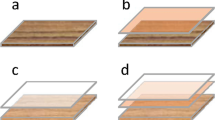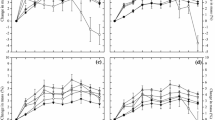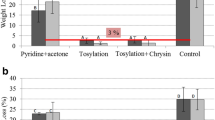Abstract
The weather resistance of Compreg surfaces depends on various factors, such as top veneer type, impregnating resin, and protective topcoats. Artificial weathering tests were performed for the first time on material types with oak and teak top veneer surfaces. Both showed strong surface brightening due to resin degradation and subsequent photobleaching of the exposed veneer surface. Directly pressed, phenolic resin-impregnated cellulose paper overlays caused significant surface stabilization.
Similar content being viewed by others
Avoid common mistakes on your manuscript.
1 Introduction
Impregnation of wood veneers with thermosetting resins and their subsequent hot compression is an effective technology that significantly improves strength properties, dimensional stability, and durability of laminated wood (Stamm and Seborg 1955). Since the natural appearance of the top veneer surface is retained during processing, compressed impregnated laminated wood (“Compreg”) represents an attractive composite for decorative applications. For its processing, rotary cut veneers of diffuse-porous hardwoods are commonly used, in Europe predominantly from beech (Dunky and Niemz 2002). Outdoor applications of Compreg require high weathering resistance of exposed material surfaces, which has been little investigated. Therefore, in a recent study, extensive work was carried out on the weather performance of Compreg surfaces with top veneers made of beech (FASY), maple (ACPL) and birch (BTXX) using an artificial weathering procedure including xenon arc radiation and spray water application (Passauer et al. 2021). It was shown that the weather resistance of Compreg surfaces strongly depends on the top veneer type and the use of transparent phenol-/melamine-formaldehyde (PF, MF) resin pre-impregnated cellulose paper films as topcoats. This brief article presents results of a subsequent study carried out for the first time on Compreg types with top veneers of oak and teak.
2 Materials and methods
Compreg boards (300 mm x 300 mm x 10 mm) were made from rotary-sliced veneers from European beech (Fagus sylvatica L., thickness: 0.4 mm) that were used as core layers. Sliced veneers from European white oak (Quercus ssp. L., QCXE) and teak (Tectonia grandis L.F., TEGR) were applied as top layers (thickness: 0.6 mm). Veneers were impregnated with a low-molecular resole type PF resin (Prefere Resins Germany GmbH, Germany; solids content: 70% ± 2%, pH value: 8.5 ± 0.5, viscosity: 300–600 mPa s) and pre-dried as described in Passauer et al. (2021). Veneers were subsequently stacked with 28 core layers at 90° to each other (cross grain) and two top veneer layers each arranged in parallel on top and bottom sides. Compreg variants QCXE_O and TEGR_O were coated with a direct pressed phenol overlay (Surfactor, Germany). Veneer stacks without and with PF films were processed in a downstroke press (Höfer Presstechnik GmbH, Austria) at 120 MPa, 130 °C and 2 min mm− 1.
Artificial weathering of Compreg specimens (145 mm x 65 mm x 10 mm) was accomplished using a weather-ometer ATLAS Ci3000 (Atlas Material Testing Technology, USA) under the following conditions: E300 − 400 = 60 ± 2 W/ m2, BCT = 65 ± 2 °C, RH = 50 ± 10%; cycle: 102 min dry, 18 min spray water.
Surface characterization was carried out on the unexposed specimens (texp = 0 h) and after 250, 500, 750 and 1,000 h of exposure. Surface changes were always monitored within identical surface spots (n = 2). Gloss measurements were performed at 60° and 85° using a gloss-meter REFO 3D (Hach-Lange, Germany). CIELab values were determined using a spectrophotometer CM-3610d (Minolta, Japan; d65 standard light, 10° standard observer with gloss trap, measuring point Ø: 24.5 mm). Color differences ΔE were calculated as Euclidian distance, with the color data of the unexposed surfaces as initial values. Light microscopic images of surface sections of Compreg were recorded using an incident light fluorescence microscope ECLIPSE E 800 (Nikon, Japan).
3 Results and discussion
Figure 1a depicts the surfaces of samples without (QCXE, TEGR) and with PF overlay (QCXE_O, TEGR_O) before and after 250 and 1,000 h of exposure.
The images of the exposed test specimens without PF overlay illustrate that the surface of both – QCXE and TEGR - became increasingly lighter as weathering progressed. This effect appears more distinct with these darker colored Compreg types than with brighter FASY, ACPL and BTXX counterparts (Passauer et al. 2021).
(a) Compreg surfaces before (background) and after 250 and 1,000 h of exposure. Samples with top veneers from European oak (QCXE) and teak (TEGR), either without or with PF overlay (QCXE_O, TEGR_O). (b) Corresponding micrographs of surface areas after 250 and 1,000 h, scale bars represent 1,000 μm; identical areas were recorded in each case
Microscopic images reveal that the surface brightening is a result of the degradation and erosion of the top PF layer (Fig. 1b, QCXE, TEGR). Since large pored vessels of the veneer surface of both QCXE and TEGR are filled with resin, resin erosion within these areas is lower. Thus, a characteristic, stripe-like and fiber-oriented damage pattern results, consisting of areas still filled or coated with PF and damaged areas with exposed and thus bleached veneer surface sections after resin erosion. Thus, this damage pattern is ultimately a consequence of the ring-porous character of both wood species. The phenomenon is less distinct with TEGR than with QCXE possessing larger pores/vessels. Moreover, TEGR is more prone to cracking, especially within the zones of wood rays (Fig. 1b, TEGR), as already shown for FASY variants (Passauer et al. 2021). This veneer surface cracking even continues into the overlay (Fig. 1b, TEGR_O), as described for the FASY_PF_O type too (Passauer et al. 2021). In contrast, the veneer surfaces of QCXE and QCXE_O remain almost free of cracks, even after 1,000 h of exposure (Fig. 1b).
Surface brightening and damaging were markedly reduced for both Compreg types in case of applying PF impregnated overlays as an additional topcoat (Fig. 1a and b, QCXE_O, TEGR_O). This indicates that cellulose fiber reinforced phenol films are quite effective in protecting the underlying dark top veneer surface from UV radiation and moisture as already shown for Compreg types with brighter top veneer surfaces (Passauer et al. 2021). However, PF overlay surfaces are also subject to weather-related damage in the following manner. Cellulose fibers that were exposed due to the degradation, embrittlement and erosion of the resin matrix of the overlay film (Fig. 1b, QCXE_O, TEGR_O) cause an increase in opacity, surface microstructuring and subsequent loss of gloss of the exposed material surface (cf. Figure 2b, c). However, the extent of surface damage is significantly reduced compared to the variants without overlay (QCXE, TEGR).
Figure 2 depicts the CIELab color changes and gloss alterations associated with weathering of the Compreg specimens. Total color changes ΔE*, shifts of lightness ΔL* (L1,000 h – L0h), red-green components Δa* (a1,000 h – a0h) and blue-yellow axis Δb* (b1,000 h – b0h) after maximum exposure time are included (Fig. 2a). The initial color values were as follows (in the order L0h, a0h, b0h): QCXE: 34.5, 7.5, 9.9; QCXE_O: 35.7, 3.3, 4.2; TEGR: 36.0, 8.6, 11.2; TEGR_O: 39.3, 6.8, 8.8 (cf. FASY: 45.4, 15.2, 19.4; ACPL: 58.1, 13.8, 26.2, BTXX: 64.7, 16, 25.4).
Both initial CIELab values and color changes after 1,000 h reveal great similarities between QCXE and TEGR on the one side and between QCXE_O and TEGR_O on the other, where teak variants were slightly less discolored. It becomes also clear that the overall color change ΔE1,000 h (13.8 … 30.4) is essentially a result of surface bleaching/brightening, which is indicated by high positive ΔL1,000 h values (13 … 30.3) nearly identical to respective ΔE1,000 h. Slight yellowing in all variants (Δb1,000 h = 2.5 … 4.5) becomes obvious, which is somewhat more pronounced in the overlay types. A possible reason for this is that yellow-colored photooxidation products of phenolic substructures of the wood, for example, quinones (Hon 2001) probably accumulate under the overlay, while they are leached out from the surfaces without overlay protection. Furthermore, there is a slight decrease in the red component, indicated by low negative Δa1,000 h values (-0.6 … -2.9), which is also slightly intensified at overlay types. This green shift is probably due to the conversion/degradation of quinones and quinone methides in the overlay that are responsible for the reddish brown color of phenolic resins (Kowatsch 2010). The above effects, bleaching, yellowing and “green shift” are common phenomena in the light-induced discoloration of dark wood species (Hon and Shiraishi 2001). They are linked to the photodegradation of primary chromophores of the wood (e.g., polyphenols, lignin), the formation of secondary chromophores (quinones, charge-transfer complexes) from colorless phenolic precursors (“leucochromophores”) by photooxidation and subsequent degradation of secondary chromophores by UV and visible light (Hon 2001).
The weather-protecting effect of direct hot-pressed phenol films becomes obvious as significant decrease of ΔE1,000 h from 30.4 (QCXE) to 17.1 (QCXE_O) and from 27.0 (TEGR) to 13.8 (TEGR_O). Accordingly, surface lightning is also reduced markedly from ΔL1,000 h = 30.3 to 16.4 (QCXE, QXCE_O) and from 26.9 to 13.0 (TEGR, TEGR_O).
Since the microstructure/surface roughness has an impact on the color of the surface of wooden materials (Hon and Shiraishi 2001), it is useful to consider the correlation between gloss alterations and total color change. Figure 2b, c depicts respective data for variants without and with overlay. Comparing the results with bright Compreg types possessing ΔE1,000 h values in the range between 12.0 (BTXX) and 25.5 (FASY) (Passauer et al. 2021), a stronger discoloration of the initially darker and more brightening QCXE and TEGR types becomes obvious. Gloss level changes caused by surface microstructuring are comparable with FASY, ACPL and BTXX types (Passauer et al. 2021). The overlay variants QCXE_O and TEGR_O possessing a smoother surface in their initial state (GU0 h = 15.6 and 17.1), exhibit a greater reduction in gloss level by 65% and 82% (GU1,000 h = 5.4 and 3) than the counterparts without an overlay (47% and 64% for QCXE and TEGR). The reason is that these already feature rougher and matte surfaces in the original state (GU0 h = 12.7 and 8.4) compared to the counterparts with overlay. Nevertheless, the protecting effect of the overlay is evident due to the significant reduction and time delay of surface discoloration/whitening of both QCXE_O and TEGR_O by a color difference of approx. 13 units each compared to QCXE and TEGR. Thus, discoloration of the variants with PF film after 1,000 h exposure roughly corresponds to the color change of the unprotected counterparts after short-term weathering over 250 h (ΔE250 h = 15.3 and 18.7).
4 Conclusion
Dark Compreg surfaces with top veneers of oak and teak show severe discoloration and structural surface damage under accelerated weathering, manifested by significant surface brightening and moderate yellowing and green shift. Partial weathering of the phenolic resin surface and subsequent photobleaching of the underlying top veneer surface are the main causes. The higher durability of the resin layer around larger wood pores filled with PF and its erosion in the intervening surface areas results in an inhomogeneous, fiber-oriented and light-dark contrasting damage pattern. Compreg with teak top veneer is more susceptible to surface cracking around the wood rays, comparable to counterparts with beech top veneer surface. Substantial surface stabilization is achieved by using hot-pressed cellulose fiber-reinforced phenol films as an additional topcoat, as already used to stabilize brighter Compreg types. Nevertheless, the overlay-treated variants show moderate surface brightening and loss of transparency of the topcoat due to separation of cellulose fibers from the resin matrix of the overlay. The use of overlay films made of microfibrillated or nanofibrillated cellulose and more durable and flexible impregnating resins is considered promising way to obtain even more weather resistant Compreg surfaces.
References
Dunky M, Niemz P (2002) Holzwerkstoffe und Leime: Technologie und Einflussfaktoren (Wood-based materials and glues: Technology and influencing factors). Springer, Berlin, pp 699–700. in German
Kowatsch S (2010) Mineral Wool Insulation Binders. In: Pilato L (ed) Phenolic Resisns: A Century of Progress. Springer, Berlin-Heidelberg, pp 209–242
Hon DNS (2001) Weathering and Photochemistry of Wood. In: Hon DNS, Minemura N (eds) Wood and Cellulosic Chemistry, 2nd edn. Marcel Dekker, Basel, pp 513–546
Hon DNS, Shiraishi N (2001) Color and Discoloration. In: Hon DNS, Minemura N (eds) Wood and Cellulosic Chemistry, 2nd edn. Marcel Dekker, Basel, pp 385–442
Passauer L, Schubert J, Schulz T, Weiß B, Flade P, Burghardt H (2021) Artificial weathering of surfaces from laminated phenol–formaldehyde resin impregnated compressed wood: Impact of top veneer type and overlay application. Eur J Wood Prod 79:567–578
Stamm AJ, Seborg RM (1955) Resin-treated, laminated, compressed wood (Compreg). FPL Report 1381, Forest Products Laboratory, United States Department of Agriculture
Acknowledgement and funding
The authors are grateful to Pagholz Formteile GmbH (Germany) for supporting the project, P. Flade (IHD) for recording micro-images and the anonymous reviewers for valuable suggestions. The project MF130036 was funded within the innovation program INNO-KOM by the Federal Ministry of Economic Affairs and Energy
Funding
Open Access funding enabled and organized by Projekt DEAL.
Author information
Authors and Affiliations
Corresponding author
Ethics declarations
Conflict of interest
On behalf of all authors, the corresponding author states that there is no conflict of interest.
Additional information
Publisher’s Note
Springer Nature remains neutral with regard to jurisdictional claims in published maps and institutional affiliations.
Rights and permissions
Open Access This article is licensed under a Creative Commons Attribution 4.0 International License, which permits use, sharing, adaptation, distribution and reproduction in any medium or format, as long as you give appropriate credit to the original author(s) and the source, provide a link to the Creative Commons licence, and indicate if changes were made. The images or other third party material in this article are included in the article’s Creative Commons licence, unless indicated otherwise in a credit line to the material. If material is not included in the article’s Creative Commons licence and your intended use is not permitted by statutory regulation or exceeds the permitted use, you will need to obtain permission directly from the copyright holder. To view a copy of this licence, visit http://creativecommons.org/licenses/by/4.0/.
About this article
Cite this article
Passauer, L., Schubert, J. Accelerated weathering of Compreg with phenol-formaldehyde resin treated top veneers of European white oak (Quercus ssp., L.) and teak (Tectonia grandis, L.F.). Eur. J. Wood Prod. 81, 281–285 (2023). https://doi.org/10.1007/s00107-022-01854-y
Received:
Accepted:
Published:
Issue Date:
DOI: https://doi.org/10.1007/s00107-022-01854-y






